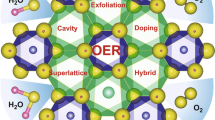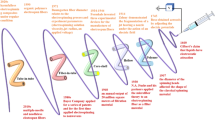Abstract
Preparation of a novel type of titanium-substrate lead dioxide anode with enhanced electrocatalytic activity for electrosynthesis is described. It has been demonstrated that in the presence of a suitable surfactant in the coating solution, an adherent and mainly tetragonal form of lead dioxide is deposited on a platinized titanium surface such that the solution side of the coating is porous while the substrate side is compact. By an analysis of anodic charging curves and steady-state Tafel plots with such porous electrodes in contact with sodium sulphate solution, it has been proved that the electrochemically active area of these anodes is higher by more than an order of magnitude when compared to the area of conventional titanium-substrate lead dioxide anodes. The electrocatalytic activity is also thereby enhanced to a significant degree.
Similar content being viewed by others
References
J. P. Carr and N. A. Hampson,Chem. Rev. 72 (1972) 679.
H. Bode, ‘Lead-Acid Batteries’ (translated by R. J. Brodd and K. V. Kordesch), John Wiley & Sons, New York (1977).
M. A. Dasoyan and I. A. Aguf, ‘Current Theory of Lead Acid Batteries’, Technicopy Ltd, Gloucester (1979).
K. V. Kordesch, ‘Batteries, Vol. 2: Lead-Acid Batteries and Electric Vehicles’, Marcel Dekker, Inc. New York (1977).
G. H. Kelsall, Electricity Council Research Centre Report, N1060, June (1977).
G. H. Kelsall and R. Stevens, Electricity Council Research Centre Report, M1266, July (1979).
A. T. Kuhn and P. M. Wright, in ‘Industrial Electrochemical Processes’ (edited by A. T. Kuhn), Elsevier (1971) chap. 14.
D. Gilroy and R. Stevens,J. Appl. Electrochem. 10 (1980) 511.
J. C. Grigger, H. C. Miller and F. D. Loomis,J. Electrochem. Soc. 105 (1958) 100.
R. Stevens and D. Gilroy,J. Microscopy 124 (1981) 265.
Ch. Comminellis and E. Plattner,J. Appl. Electrochem. 12 (1982) 399.
D. Gilroy,12 (1982) 171.
F. Hine, M. Yasuda, T. Iida, Y. Ogata and K. Hara,Electrochim. Acta 29 (1984) 1447.
A. T. Kuhn, ‘The Electrochemistry of Lead’, Academic Press, London (1979).
F. Hine, M. Yasuda, T. Iida, Y. Ogata and K. Hara,Electrochim. Acta 29 (1984) 1447.
W. Mindt,J. Electrochem. Soc. 116 (1969) 1076.
B. N. Kabanov, E. S. Weisberg, I. L. Romanova and E. V. Krivolapova,Electrochim. Acta. 9 (1964) 1197.
P. C. Foller and C. W. Tobias,J. Electrochem. Soc. 129 (1982) 567.
F. Hine, M. Yasuda, T. Noda, T. Yoshida and J. Okuda,J. Electrochem. Soc. 126 (1979) 1439.
M. A. Dasoyan and I. A. Aguf, ‘Current Theory of Lead-Acid Batteries’, Technicopy Ltd, Gloucester (1979) p. 39.
R. Ramesham, PhD dissertation, Indian Institute of Science, Bangalore (1983).
Author information
Authors and Affiliations
Rights and permissions
About this article
Cite this article
Munichandraiah, N., Sathyanarayana, S. Insoluble anode of porous lead dioxide for electrosynthesis: preparation and characterization. J Appl Electrochem 17, 22–32 (1987). https://doi.org/10.1007/BF01009128
Received:
Revised:
Issue Date:
DOI: https://doi.org/10.1007/BF01009128




